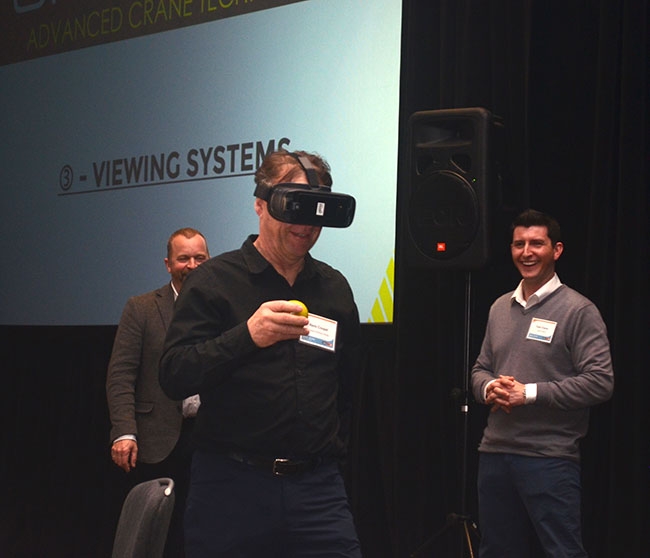
News
WORKSAFEBC Talks Tower cranes
Tower crane professionals come to Richmond to learn more about ensuring safe operations.
March 28, 2018 By Andrew Snook

For the first time in more than a decade, tower crane professionals across British Columbia came together for the Tower Crane Industry Safety Conference, hosted by WorkSafeBC at the Sheraton Vancouver Airport Hotel in Richmond, B.C. in March. More than 150 crane professionals that travelled to Richmond to attend a variety of sessions related to tower crane safety.
Dan Strand, director at WorkSafeBC, opened the conference by discussing the importance of industry coming together for events like this one.
“It’s been 12 years since we’ve held a conference like this,” he said, adding that much has changed in the tower crane industry since the last conference. “But what hasn’t changed is a need to keep people safe.”
Strand told the crowd that everyone involved in the industry needs to work together to address tower crane safety issues to find solutions that ensure that everyone goes home safely.
“We’ve had 12 serious incidents in the past 12 months,” he told the crowd. “Behind these statistics are people, people that are at risk.”
Crane Safety Initiative
Doug Younger, occupational safety officer for WorkSafeBC, offered an overview of the 2018-2020 WorkSafeBC Crane Industry Initiative.
The agency’s tower crane strategy is “to identify and eliminate specific tower crane hazards and unsafe work practices that have the potential to cause serious injury, death, or catastrophic equipment failure.”
Younger told the crowd that the large number of serious incidents related to safe operation of tower cranes is what spurred WorkSafeBC’s focus on tower cranes.
In addition to the 12 tower crane incidents that were reported in 2017-18 in B.C., there have been 250 tower crane incidents reported between 2008 and 2017. The majority of the incidents were caused by crane and hoist equipment failures; contact with overhead conductors, tower cranes and concrete pumps; and workers being struck by falling loads or by rigging and other objects.
Younger said that the true number of incidents is most likely more than this, since WorkSafeBC may not hear about all incidents, and its officers may not actually document every single incident. Younger told the crowd that he is amazed at how many close calls and near misses he has seen over the years; and that there have been no fatalities stemming from these incidents over the past 10 years.
“This industry cannot rely on luck,” Younger said. “It’s unbelievable how nobody got seriously hurt [in these incidents]… we need to take a serious look and improve our safety stats, we need to improve our record.”
The bulk of the incidents in B.C. have taken place in the Vancouver area, where most of the lifting work is taking place. Out of the 250 incidents from 2008 to 2017, 126 occurred in Vancouver West and 14 occurred in Vancouver East. Other cities where a significant number of incidents occured include Surrey (15); Victoria (14); Kelowna (13); and Courtenay (8).
Younger discussed WorkSafeBC’s various tower crane initiatives, which include crane operator certification changes and updates; pre-erection and annual inspection requirements to the CSA standard; rigging standard and rigger qualification; equipment zoning (slew-limiting devices); and below-the-hook lifting device design and documentation.
Red Seal certification
Kristin Leversage, program development officer with the Industry Training Authority (ITA), offered an update on the Red Seal Certification Program for tower crane operators, which was launched on Dec. 1, 2017. The ITA is now issuing Red Seal endorsements for tower crane operators.
Red Seal program completion requirements include:
- Minimum of 3,000 hours;
- Three written exams: Level 1, Level 2 and Interprovincial Red Seal exam; and
- -A practical assessment (no change).
For trade workers who are already certified, she said that all ITA certifications are still valid and no action is required. However, if a certified trade worker wants to obtain a Red Seal endorsement on their Certificate of Qualification, they can do so by passing the Interprovincial Red Seal exam.
New technologies on display
New products for improving safety were also on display at the conference, including zoning devices and anti-collision technologies and cameras. Paul Roussel, manager for Opticrane, discussed some of the latest innovations for improving safety operations for tower crane operations; including how zoning devices and anti-collision (AC) devices are able to warn operators about hazards and prevent encroachment on prohibited areas, when partially or fully integrated. All cranes manufactured in Europe after 2006 have to be able accept any manufacturer’s AC technologies.
“They all have software that can be run in conjunction with these systems and can send you alerts,” Roussel explained. “You now can have a system that tells you how much mileage a crane is doing in a day for preventative maintenance, how many alerts you get in a day, and how often two tower cranes may be ‘fighting’ for the same lifts… with data logging monitoring system you can basically log anything.”
Companies can then use this data for e preventative maintenance and alerts, as well as defending itself against accusations of breaching limits of approach, since the data can record how the tower crane has been operating. For more coverage of the conference, visit www.rocktoroad.com.
Print this page